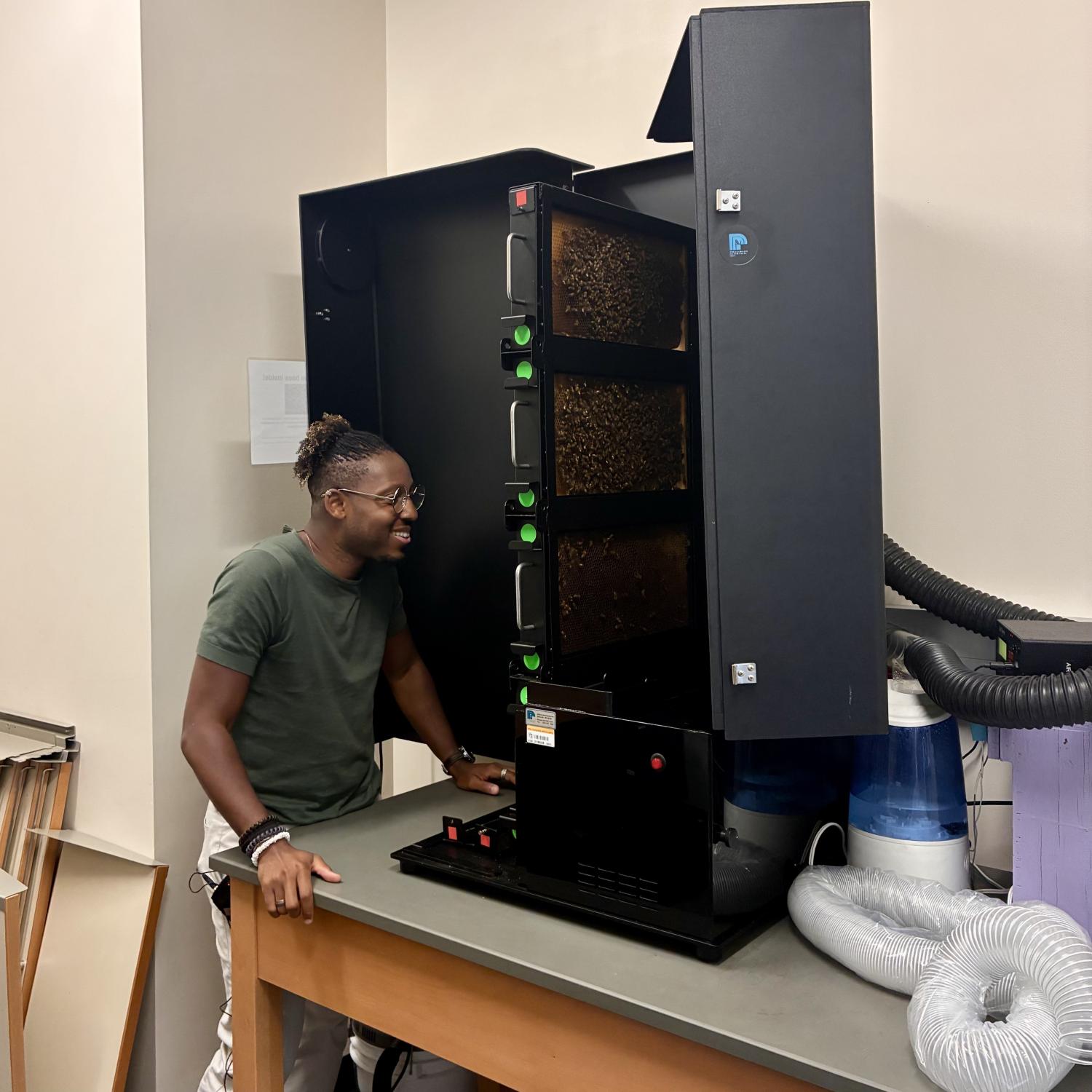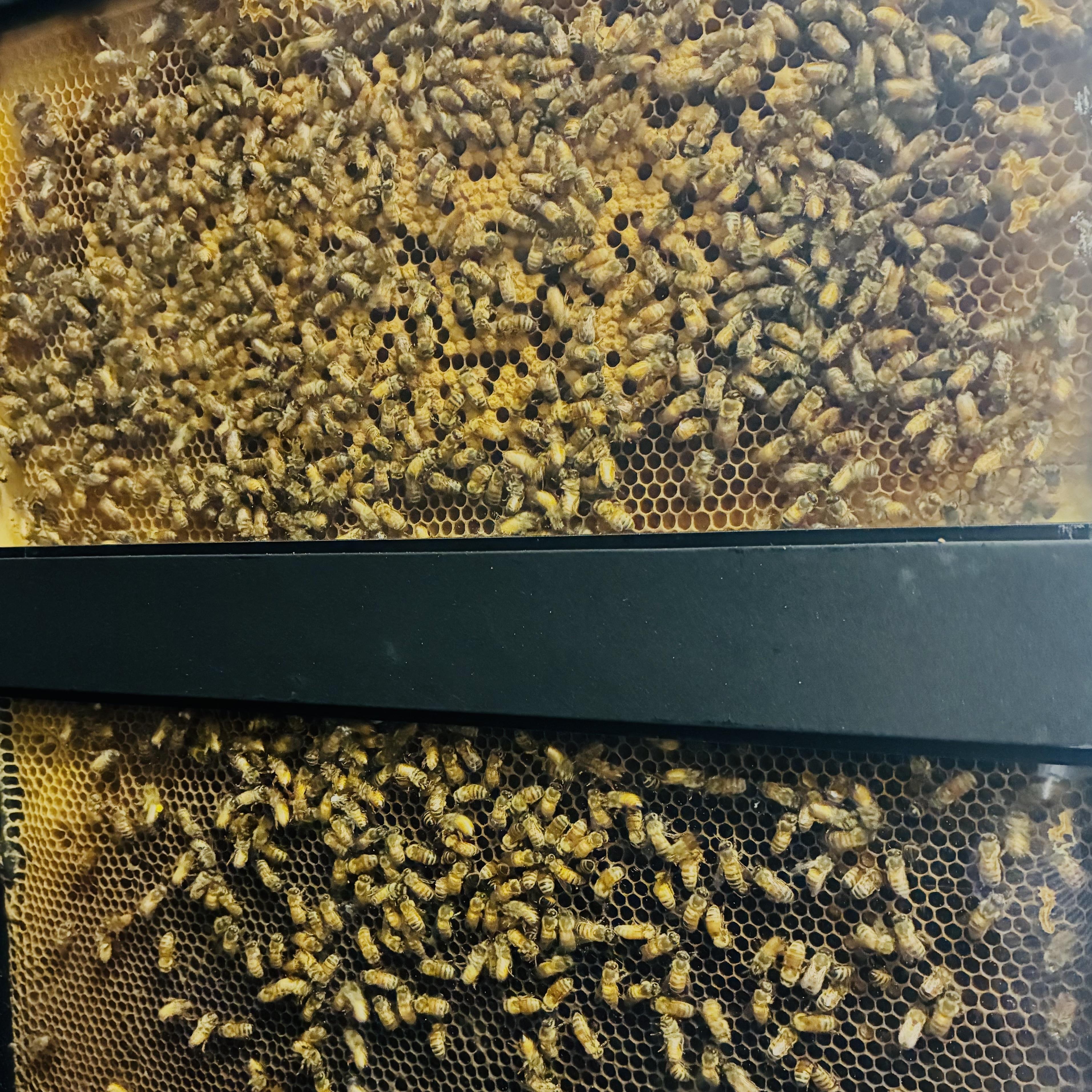Honeybees are dying in record numbers. This scientist is racing to save them
Honeybees fly into beehive. (Credit: Kai Wenzel/Unsplash)
The first sign something was wrong came from the silent beehives.
When Samuel Ramsey visited his family in Maryland this March, he and his father, an avid beekeeper, approached the 10 bee boxes in his grandmother's yard. They were expecting to hear the familiar hum of insects awakening from their winter rest. They pictured the smell of warm, sweet beeswax.
Instead, the Ramseys found thousands of lifeless bees piling up at the bottom of the hives.
As an entomologist in the Department of Ecology and Evolutionary Biology and the BioFrontiers Institute, Ramsey studies honeybees and why they haven’t been doing so well lately.
“When you open the top of the box, and there's a silence of the bees that you're greeted with, it’s a very upsetting scene for beekeepers and bee researchers to see,” said Ramsey.
Ramsey is not alone. Across the United States, beekeepers are reporting the same grim discovery as unprecedented honeybee losses sweep through the nation’s colonies. Researchers predict that beekeepers in the country have lost more than 62% of their colonies over the winter. In some places, the number could reach 70%.
“Since we've started measuring honeybee losses, this is the worst that we have ever seen,” Ramsey said. “We now have net losses of honeybees that will impact everything from honey production to foods that we consume on a regular basis.”
Losing over half of the colonies passes a critical threshold where beekeepers can no longer divide the surviving colonies and wait for each new group to repopulate, a strategy that has worked when losses hovered below 50%.

Samual Ramsey co-designed an observation beehive so the team can monitor how the honeybees without opening the box. (Credit: Yvaine Ye)
Scientists say that a range of factors, including climate change, pesticides and, particularly, parasites are likely contributing to the massive die-off. Ramsey is racing to identify the causes and find solutions. He thinks bees on the other side of the world might hold clues to prevent the tragic decline from happening again next year.
Collapsed colonies
Honeybees are among the most efficient pollinators in nature, contributing to about $18 billion worth of crops in the United States. A decline in honeybee populations could threaten the yields of crops like apples, peaches and almonds. It would also affect livestock production, because the plants that make animal feed also rely on pollination.
Normally, about 10% of bees die as they brave the winter months due to natural causes like cold weather.
In 2006, U.S. beekeepers began noticing their bees dying off or vanishing in much larger numbers, resulting in colony losses of about 30% to 50% in a phenomenon known as colony collapse disorder. But around 2011, the disorder mysteriously disappeared, so quickly that scientists never identified a cause.
Strangely, U.S. honeybee colonies continue to suffer even after the disorder disappeared.

A bee colony in an observation beehive in Samuel Ramsey's lab. (Credit: Yvaine Ye)
“The bees never bounced back, and it’s incumbent on us as scientists to figure out what’s holding them back from returning to their healthiest state,” Ramsey said. He added that many factors are stressing out honeybees, but at the center of the crisis is a parasitic mite, Varroa destructor.
These tiny mites attack a honeybee’s fat body, an important organ that manages the insect’s metabolism, immune system, body temperature and its ability to break down pesticides.
Scientists have found that more than 98% of colonies in the United States already have varroa mites.
The parasite also makes all the other problems bees are dealing with worse. For example, the mites damage the honeybee’s ability to handle extreme temperatures. They also weaken the bee’s ability to fend off other bacterial or viral infections.
At the same time, a changing climate is causing wildflowers to bloom earlier than usual, often before bees emerge from winter to collect food. Infected bees are even less likely to survive when resources are scarce.
“These mites were already present last year and the year before and the year before and the year before, going all the way back to 1987. The reason why mites may be a greater issue now is because they compound everything else happening around them,” Ramsey said.
Natural immunity
Traditional methods of mite control often involve pesticides, but varroa mites have developed resistances to these chemicals and are becoming more virulent over time.
Ramsey and his team are searching for a solution. In recent years, they have traveled around the world to collect genetic data from every existing species of honeybee and to observe how they interact with their native parasites.
He has previously discovered that some honeybees in Southeast Asia, where varroa originated, are resistant to mites. The secret could lie in genes.
“Nature has done a spectacular job of solving problems that we are still trying to figure out how to solve. So instead of reinventing the wheel, it would be a much better idea for us to better conserve the organisms that have already figured out how to solve life's problems and study them,” Ramsey said.
He added that if scientists could transfer these genes to honeybees in the United States, it might help them develop immunity against varroa.
This summer, Ramsey had planned to travel to Vietnam, Borneo and Thailand where he hasn’t yet collected DNA from honeybees. But because of funding issues, he had to postpone the trips.
“In order for us to do what we can to make sure that this level of die-off never happens again, we need better funding for research. This is the worst possible time for us to be reducing funding for agricultural and bee research,” Ramsey said.
There are also some actions people can take, he said. For example, planting native wildflowers around homes could provide much-needed food for bees.
“It’s endearing to think that these little insects have increased the carrying capacity of our country so we can thrive. I’m determined to figure out how to make them thrive too,” Ramsey said.


